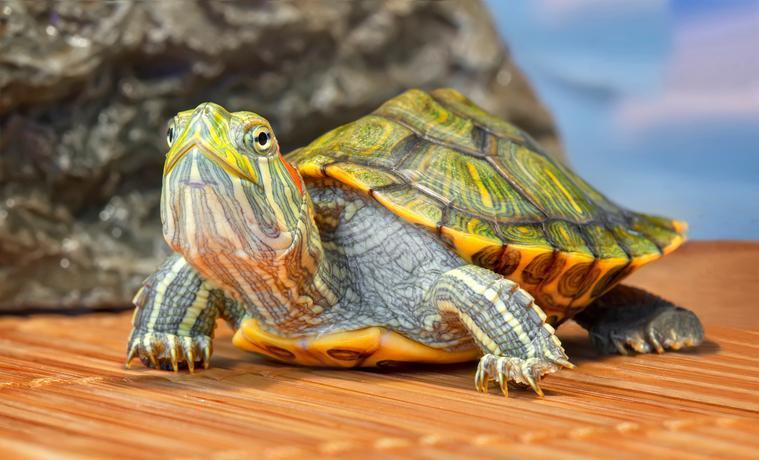How to Estimate a Turtle's Age


With their slow movements and protective shells, turtles have captivated humans for centuries. These fascinating reptiles boast a rich history, being some of the oldest living creatures on Earth. While some turtle species call the land home, others have adapted to a life in the water. One of the greatest mysteries surrounding these shelled wonders is their age. Their incredible longevity makes pinpointing their exact age quite challenging.
This AnimalWised article delves into the science behind estimating a turtle's age. We'll explore the methods scientists use to unlock these age-related mysteries.
Characteristics of land turtles
Land turtles or tortoises are a diverse group of reptiles exceeding 40 recognized species. These herbivores, known for their peaceful nature and remarkable longevity. Their shells, a key defense mechanism, are composed of bony plates covered in keratin and come in various shapes and sizes.
Land turtles inhabit a wide range of ecosystems across the globe, from arid deserts to lush rainforests. Their distribution encompasses continents like Africa, Asia, South America, and Europe, with some species even residing on islands. Notably, the Galapagos giant tortoise is the largest living land turtle species, reaching weights exceeding 500 pounds, while the speckled padlopper tortoise is considerably smaller, measuring only a few inches long.
These cold-blooded (ectothermic) reptiles rely on external sources to regulate their body temperature. During cooler periods, they may burrow underground to maintain warmth. Their diet primarily consists of plants and some insects, with their strong jaws and beak-like mouth specifically adapted for this purpose. Calcium is a crucial element for healthy shell development, necessitating a diet that provides sufficient amounts.
While land turtles can be captivating companion animals, it's important to acknowledge their long lifespan and specific environmental requirements. Owning a land turtle requires a significant commitment to providing proper care, including a suitable habitat and a specialized diet. Unfortunately, some

Characteristics of sea turtles
Sea turtles are a diverse group of reptiles with seven recognized species. These marine animals vary significantly in size, shape, and coloration. Unlike land turtles, sea turtles lack visible teeth and external ears. Their bodies are covered in specialized skin that allows them to detect vibrations and low-frequency sounds underwater, but their hearing is not comparable to humans.
Sea turtles have streamlined bodies well-suited for an aquatic lifestyle. Powerful flippers enable them to navigate ocean currents with agility, and their excellent underwater vision aids in finding food and avoiding predators. Their diet varies by species, but they primarily consume a combination of algae, mollusks, crustaceans, and fish, obtaining essential nutrients for their shells. Notably, sea turtles are mostly solitary creatures with few natural predators as adults.
Despite being primarily aquatic, sea turtles return to land to lay eggs on beaches. This nesting behavior is vital to their life cycle. Determining their exact age is challenging, but scientific estimates suggest they can live well over 100 years. Researchers use various methods to estimate age, including analyzing growth rings in their bones, similar to tree ring dating.
Dive deeper into the fascinating life cycle of sea turtles. Read on to learn more.
How to know the age of a turtle?
Accurately determining a turtle's age is difficult because they lack clear growth markers like teeth, which are commonly used to age mammals.
This challenge applies to both land and sea turtles, although some key differences in their biology and lifestyle necessitate slightly varied approaches for age estimation. Let's explore the most common methods, which provide indirect age assessments:
Scute growth rings
Examining the scutes (individual plates) of a turtle's shell may reveal growth rings or lines. These lines are believed to correspond to periods of growth, but their clarity can be influenced by factors like nutrition and environmental conditions. For land turtles, growth rings on their scutes are often more visible due to environmental variations. In contrast, growth rings on sea turtle shells may be less distinct, and examining internal bone growth rings might be more reliable, though this is an invasive procedure.
Size comparison
Another method involves measuring the turtle's carapace (upper shell) length and comparing it to established size data for its specific species. However, this method has limitations. Captive-raised turtles often grow larger than wild individuals, potentially leading to inaccurate age estimations. Size comparison can be somewhat helpful for land turtles, especially when considering captive-raised individuals with documented growth patterns. However, this method is less reliable for sea turtles due to factors like varying food availability in the ocean.
Skeletochronology
This method involves examining growth rings in a turtle's bone, typically the long bone in the forelimb (humerus). Similar to growth rings in trees, these rings can reveal growth patterns and provide a more accurate age estimate compared to shell scutes. However, this is an invasive procedure that requires sacrificing the animal or a bone sample, making it unsuitable for live animals.
Radiography and CT Scans
X-rays and CT scans can be used to visualize growth rings within the turtle's shell or bones without harming the animal. However, this technique is expensive and requires specialized equipment, limiting its widespread use.
Genetic Analysis
While still under development, some research explores the possibility of estimating age based on genetic markers in a turtle's blood or tissue. This method is not yet widely available and requires further research for practical application.
It's important to note that various factors, including genetics, diet, and environment, can impact a turtle's growth rate, making precise age determination difficult.
To learn more about the fascinating anatomy of turtles, be sure to read this other article.

How long do turtles live?
The lifespan of a turtle depends heavily on the species and whether it lives on land or in water. Here's a breakdown:
Sea turtles
Estimating the lifespan of sea turtles is challenging due to their long lifespans and difficulty studying them in the wild. Scientific estimates suggest they can live well over 100 years, with some individuals potentially exceeding 150 years.
Land turtles
Lifespans of land turtles vary depending on the species. Some species, like the gopher tortoise (Gopherus polyphemus), can live up to 80 years, while others, like the box turtle (Terrapene carolina), can exceed 100 years. Factors like diet, habitat quality, and presence of predators can influence their lifespan in the wild. Captive land turtles, with proper care, can potentially live longer than their wild counterparts.
Freshwater turtles
Freshwater turtles kept as pets can have varying lifespans depending on the species. Some commonly kept species, like the red-eared slider, can live for 30-50 years with proper care. However, their lifespan can be significantly shortened due to factors like inadequate diet, improper habitat, and lack of veterinary care.
For a deeper dive into turtle lifespans and the factors influencing their longevity, check out this other article.

If you want to read similar articles to How to Estimate a Turtle's Age, we recommend you visit our Facts about the animal kingdom category.








